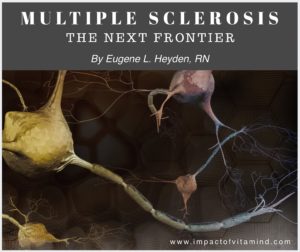More to Consider in the Battle Against Multiple Sclerosis: A Case Report

Last revision: 02-18-24
By Eugene L. Heyden, RN
It is now clear that opioid receptors participate in the function of the cells of the immune system, and evidence suggests that opioids modulate both innate and acquired immune responses. ~ McCarthy et al., 2001
If you haven’t already heard, let me introduce you to low-dose Naltrexone (LDN). Then, we’ll meet Sharon. And before you go, I’ll give you a little homework assignment. (You can thank me later.)
Many cells of the body, including immune cells, have what are called opioid receptors. Opioid receptors respond to endogenous (generated within) molecules that resemble opioids (endorphins), as well as respond to the opioid drugs such as morphine and fentanyl. Surprisingly, immune responses can be modified, indeed suppressed, by opioid-like molecules, working in concert with the opioid receptor. Things might be a little complicated here. I’ll keep it simple.
As the story goes, naltrexone, is capable of occupying the opioid receptor, and when given in a low dose, occupies (antagonizes) the opioid receptor for only a few hours. Then, when this effect “burns off,” a rebound effect is emerges, to include the generation of more opioid receptors and the signaling for greater endorphin availability (Brown and Panksepp, 2008). This “rebound effect” somehow favorably suppresses the immune response. “Basic science evidence supports that concept by showing that low- and high-dose opioid antagonists have quite different impacts on the physiologic system.” (Younger et al., 2014) In theory,
“The most prevalent hypothesis, advanced by Dr. Ian Zagon and colleagues, states that inducing a small and transient opioid blockade will prompt the body to compensate by upregulating both endogenous opioids and opioid receptors. The opioid upregulation effect of temporary naltrexone or naloxone blockade has been demonstrated multiple times previously. This “opioid rebound” effect could have multiple impacts on health and quality of life, including enhanced endogenous analgesia and repression of critical immune factors.” (Younger et al., 2014)
Naltrexone is not a hammer you can beat an offending, proinflammatory cytokine (like TNF-α) over the head with. It is a drug that can be strategically deployed to create an anti-inflammatory response. And this anti-inflammatory response, not an anti-inflammatory property of the drug itself, is what can be deployed in the battle against multiple sclerosis.
Are you getting the picture? Low-dose naltrexone is not an anti-inflammatory drug, per se, it is a drug that is used to trick the immune system into becoming less immunoreactive, less menacing, less likely to destroy the fabric of a life. And with that, let’s check in with Sharon to see what LDN has done for her.
Case report: Sharon
I regularly keep tabs on an individual who uses LDN daily in her battle against multiple sclerosis (MS). I have given her the name Sharon.
Sharon was first diagnosed with MS in 1989 at the age of 41, following a sudden loss of vision. Her vision returned in short order, but her MS gradually seized control. Her health deteriorated over time, and to the point she needed to use a wheelchair due to limited mobility and to conserve energy. Various MS medications were tried but did not help, and Sharon began to react to them in a negative manner. But something needed to be done. MS was destroying her life.
In 2002, Sharon was introduced by her neurologist to the promise of LDN. LDN was prescribed, a reputable compounding pharmacy was located, and in short order the new medication was started. Almost immediately after starting LDN, Sharon noticed improvement. “In three days, I had a surge of energy and was able to walk normally again.” All her symptoms improved, then vanished. It is now 2022. Sharon is 75 years old, and her remission has held. She continues taking LDN, daily. But there was one little problem that showed up along the way, and an important lesson learned. Pay close attention! This is important!
Approximately ten years ago, Sharon had changed to a new compounding pharmacy. And although she faithfully took her LDN, she began experiencing the symptoms of MS once again. So, Sharon went online to see if others had experienced this same sort of thing. She learned that others, too, had had this experience when switching compounding pharmacies, and experienced a return to their baseline status after switching to a compounding pharmacy with expertise in compounding LDN. (It may have something to do with the choice of fillers used, or if it is formulated to be slow-released—a form of the drug found to be completely ineffective.) Sharon located a compounding pharmacy in New York City, noted for their success with LDN, and soon after she started taking a new batch of LDN, her symptoms vanished once again, and rather quickly. Unfortunately, after being her pharmacy for many years, recently it went out of business. Having learned the lesson of how important it is to have the right pharmacy, Sharon searched for and found a new one, a pharmacy recognized as having expertise in compounding LDN. They must be doing it right, as her remission continues to this very day (October 5, 2022). Doing the math, with LDN, Sharon has experienced 20 years of remission from a disease most dreadful.
Sharon is not the only one
“The two subjects with entercutaneous and rectovaginal fistulas had closure of the fistulas with LDN therapy. Unexpectedly, one study subject with Crohn’s disease and multiple sclerosis was found to have improvement in her neurological symptoms and manifestations of multiple sclerosis with LDN.” ~Smith et al., 2007
Scattered throughout the internet are the stories of success with LDN by other individuals besides Sharon. If you look, you will find.
Vicki tells her story at LDNScience.org (to read, click here).
And while on the site, check out the stories of 23 other individuals who benefited from LDN in the battle against MS. To access, go to the navigation bar above Vicki’s story, click on Patients, then in the drop-down menu, click Patient Stories. There you will find a Search by diseases box. Click the down arrow and locate then click MS (Multiple Sclerosis). And there you go!
In conclusion
“The use of LDN has gained widespread public acceptance, inspite of the lack of enthusiasm from prescribing physicians. It is incumbent upon us to investigate this drug, for it offers the potential of an oral therapy for MS with few side effects. At the very least, by showing a lack of efficacy, patients can be persuaded from using LDN in lieu of the standard therapies of MS.” (Agrawal, 2005)
Recommended viewing:
Related post (Click image to open)
References
Agrawal YP. Low dose naltrexone therapy in multiple sclerosis. Medical hypotheses. 2005 Jan 1;64(4):721-4. https://www.sciencedirect.com/science/article/pii/S030698770400578X
Brown N, Panksepp J. Low-dose naltrexone for disease prevention and quality of life. Medical hypotheses. 2009 Mar 1;72(3):333-7. https://www.sciencedirect.com/science/article/pii/S0306987708005070
McCarthy L, Wetzel M, Sliker JK, Eisenstein TK, Rogers TJ. Opioids, opioid receptors, and the immune response. Drug and alcohol dependence. 2001 Apr 1;62(2):111-23. https://www.sciencedirect.com/science/article/pii/S0376871600001812
Smith JP, Stock H, Bingaman S, Mauger D, Rogosnitzky M, Zagon IS. Low-dose naltrexone therapy improves active Crohn’s disease. Official journal of the American College of Gastroenterology| ACG. 2007 Apr 1;102(4):820-8. https://journals.lww.com/ajg/Fulltext/2007/04000/Low_Dose_Naltrexone_Therapy_Improves_Active.19.aspx
Younger J, Parkitny L, McLain D. The use of low-dose naltrexone (LDN) as a novel anti-inflammatory treatment for chronic pain. Clinical rheumatology. 2014 Apr;33(4):451-9. https://link.springer.com/article/10.1007/S10067-014-2517-2
DISCLAIMER: This article is offered solely for informational purposes. The information contained therein and opinions expressed should be evaluated for accuracy and validity in the context of opposing data, new information, and the views and recommendations of a qualified health care professional, and not to be substituted for professional judgment and guidance or to provide a reason to neglect or delay appropriate medical care for self or for others. It is the reader, and reader only, who bears the responsibility for any actions that could be construed as being a response to the information presented. The statements and opinions expressed by the author have not been reviewed or approved by the FDA or by any other authoritative body, nor is the author endorsing any product or specific therapy mentioned. This article and the opinions contained therein are offered to the reader to broaden his or her understanding of the issues discussed and to help identify options that may be suitable for the individual to pursue, on behalf of self or others, under approval and direction of a qualified physician or medical team member. All questions of a medical nature which arise from reading this article should be directed at qualified health care professional. There are no guarantees that a suggested website and internal links are safe to visit or open or are currently available.
Copyright © 2022 Eugene L. Heyden, RN
All Rights Reserved

